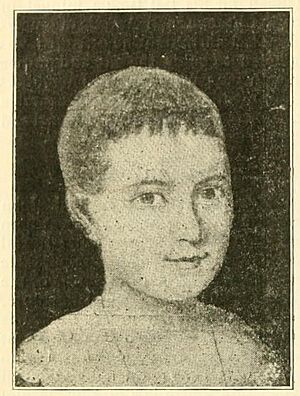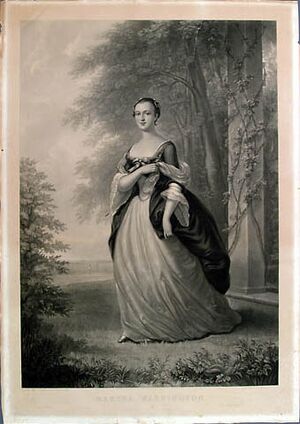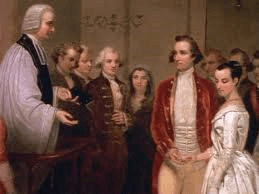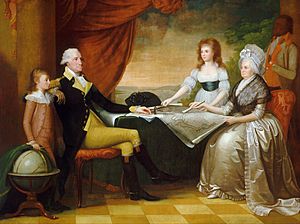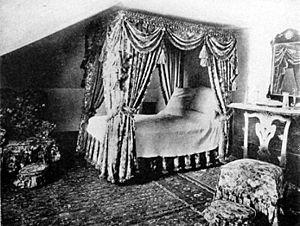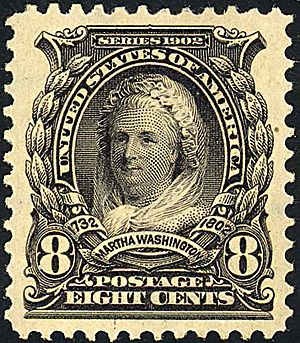Martha Washington facts for kids
Quick facts for kids
Martha Washington
|
|
|---|---|

|
|
| First Lady of the United States | |
| In role April 30, 1789 – March 4, 1797 |
|
| President | George Washington |
| Preceded by | Position established |
| Succeeded by | Abigail Adams |
| Personal details | |
| Born |
Martha Dandridge
June 2, 1731 Chestnut Grove, Virginia, British America |
| Died | May 22, 1802 (aged 70) Mount Vernon, Virginia, U.S. |
| Resting place | Mount Vernon, Virginia, U.S. 38°42′28.4″N 77°05′09.9″W / 38.707889°N 77.086083°W |
| Spouses |
Daniel Parke Custis
(m. 1750; died 1757) |
| Children |
|
| Parents | John Dandridge Frances Dandridge |
| Signature | |
Martha Dandridge Custis Washington (born June 2, 1731 – died May 22, 1802) was the wife of George Washington. He was the first president of the United States. Even though the title "First Lady" was not used until after she died, Martha Washington was the very first first lady. She helped create the role for all future presidents' wives. During her time, people called her "Lady Washington". Historians often rank her as one of the most important first ladies.
Martha Dandridge first married Daniel Parke Custis in 1750. They had four children, but only two lived to be adults. She became a widow in 1757 when she was 26 years old. She inherited a very large estate. She married George Washington in 1759 and moved to his home, Mount Vernon. Her youngest daughter died in 1773. Martha and George Washington did not have any children together.
Martha Washington became a symbol of the American Revolution. This happened after her husband became the leader of the Continental Army. She took on a motherly role, visiting the army camps each winter when fighting stopped. Her only surviving child, John, died from an illness during the war. After the war ended in 1783, Martha wanted to retire at Mount Vernon. But she returned to public life when her husband became president in 1789.
She was not happy about being the president's wife at first. But she became a national celebrity. She felt that her life was restricted and she missed her quiet retirement. Martha hosted weekly social events. She knew that how she acted would reflect on the new country. She tried to balance being dignified, like a leader's wife, with being humble, like someone from a republic. The Washingtons returned to Mount Vernon in 1797. She spent her retirement greeting visitors and giving advice to future first ladies. She became a widow for the second time in 1799. She died two and a half years later in 1802.
Contents
Early life of Martha Washington
Martha Dandridge was born on June 2, 1731. Her parents' plantation was called Chestnut Grove in the Colony of Virginia. She was the oldest daughter of John Dandridge, a Virginia planter from England. Her mother was Frances Jones. Martha had three brothers and four sisters. As the oldest of eight children, she learned to be a caretaker from a young age.
Martha's father knew many important people in Virginia, even though he was not very rich. Martha learned how to act like a woman from a wealthy family. She received a good education for a girl at that time. It was not as good as her brothers' education, though. She was very good at horseback riding. Once, she rode her horse up and down the stairs of her uncle's house! Her father was so impressed that she didn't get in trouble.
Marriage to Daniel Parke Custis
In 1749, Martha Dandridge met Daniel Parke Custis. He was the son of a very rich planter in Virginia. They wanted to get married. Daniel's father was very picky about who his son would marry. But Martha eventually won his approval. Martha married Daniel Custis on May 15, 1750. He was 20 years older than her.
After they married, Martha moved to Daniel's home. It was called White House Plantation on the Pamunkey River. They had four children: Daniel (born 1751), Frances (born 1753), John (born 1754), and Martha (born 1756). Sadly, Daniel died in 1754 and Frances died in 1757. Martha's father owned about 15 to 20 enslaved people. Her husband owned nearly 300. This made him one of the wealthiest men in Virginia.
Martha became a widow when she was 26 years old. Her husband died from heart failure. She inherited a large estate from him. After his death in 1757, she received one-third of his property. The other two-thirds went to their two young children. Her inheritance included about $33,000 (a huge amount back then), 17,000 acres of land, and hundreds of enslaved people. Managing all these legal and financial matters was a big challenge for Martha. She was also raising her two children and grieving her losses. She had to manage the farms and oversee the enslaved people. She was very capable and even bargained with merchants in London for the best prices for tobacco.
Marriage to George Washington
Courtship and wedding
Martha Custis, age 27, and George Washington, age 26, married on January 6, 1759. The wedding took place at the White House plantation. George Washington lived and owned land nearby. He likely knew both Martha and Daniel Parke Custis before Daniel died.
One story says that George Washington visited Martha Custis twice in March 1758. The second time, he left with a promise of marriage. Another story says they met through a friend, Colonel Chamberlayne, in May 1758. At that time, another wealthy planter, Charles Carter, was also trying to court Martha.
The couple spent their honeymoon at the Custis family's White House plantation. Then they stayed in Williamsburg, where George was a representative. Finally, they moved to his Mount Vernon estate. When they married, Martha was one of the richest widows in the Thirteen Colonies. Their marriage was happy for 40 years. They had similar views and respected each other. They both liked a steady daily routine and cared a lot about family.
Life at Mount Vernon
From 1759 to 1775, the Washingtons lived at Mount Vernon. They managed their plantation there. Martha ran the household and often entertained visitors. She knitted and oversaw the making of clothes. She also became skilled at preserving meat in their smokehouse. Martha often had guests for dinner or for longer stays. The family became more important in Virginia's political and social life.
George Washington used Martha's wealth to buy more land and enslaved people. He more than tripled the size of Mount Vernon. For over 40 years, the enslaved people Martha inherited worked on the plantation alongside George's. By law, neither Martha nor George could sell the land or enslaved people that Martha had inherited.
The Washingtons did not have children together. But they raised Martha's two surviving children. Martha was very protective of them. This was especially true after her first two children died and her daughter Patsy was found to have epilepsy. In 1773, Patsy died at age 17 during an epileptic seizure. Martha's last surviving child, John, left college that fall. He married Eleanor Calvert in February 1774. The Washingtons hoped for more children throughout their marriage, but they were unable to have any.
American Revolution
Early revolution
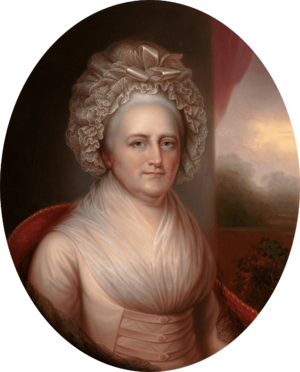
Life for the Washingtons changed when the American Revolution grew more serious in the 1770s. Some rumors spread that Martha was a Loyalist, but she always shared her husband's political beliefs. She strongly supported his role in the Patriot movement. She stayed at Mount Vernon when he became the leader of the Continental Army in 1775. She oversaw the building of new parts of their home. Later, she moved to her brother-in-law's house to be less of a target during the war.
The revolution was the first time Martha and George were apart for a long time. In the fall of 1775, Martha traveled to Massachusetts to meet her husband. On her journey north, she experienced being famous for the first time. People saw her as the wife of a famous general. She joined him in Cambridge, where the army officers were based. While there, she hosted guests for the officers. She also sewed clothes for the soldiers at camp. She encouraged other officers' wives to do the same. This led to a sewing circle that helped the war effort. Martha was scared by the gunfire from the nearby Siege of Boston, but she hid it from others. She went with her husband when the army moved to New York. But she was sent to Philadelphia when British forces got closer.
Independent United States
The American Revolution became more stressful for Martha after the Declaration of Independence was signed. The dangers her husband faced in battle increased. Each winter, Martha would join her husband at his army camp. Fighting would stop during winter, and her visits helped boost the soldiers' spirits and her husband's. The places she stayed were not always comfortable or safe. General Lafayette said that she loved "her husband madly".
Her husband kept Martha informed about the war. Sometimes she even helped him with paperwork. She was even allowed to know military secrets. Each spring, when fighting started again, she returned to Mount Vernon. She became a symbol of the war effort alongside her husband. She was seen as a grandmotherly figure who cared for the soldiers.
The Continental Army stayed at Valley Forge for the winter of 1777-1778. Martha traveled for 10 days and hundreds of miles to join her husband in Pennsylvania. On April 6, 1778, Elizabeth Drinker and three friends visited Valley Forge. They wanted to ask General Washington to release their husbands from jail. The men were Quakers who refused to swear loyalty to the American revolutionaries. Since the General was busy, the women visited with Martha. Drinker later described her as "a sociable pretty kind of Woman."
The Washingtons' son, John, was helping his father during the siege of Yorktown in 1781. He died from "camp fever," which was a common illness like epidemic typhus. After his death, the Washingtons adopted his two youngest children. They were Eleanor (Nelly) Parke Custis and George Washington Parke (Washy) Custis. The Washingtons also helped many other relatives and friends' children with personal and financial support.
Postwar retirement
The Washingtons returned to Mount Vernon in 1783. They stayed there for much of the time before the new government was formed. They lived in retirement with their nephew, nieces, and grandchildren. Martha, whose health was not as good, thought her husband was done with public service. She spent her time raising their grandchildren. She worried about their health because all four of her own children and many other relatives had died from illness.
She also started hosting guests at Mount Vernon again. The house was often full of visitors. She asked several of her nieces and other young women to help her. Their quiet life at Mount Vernon was interrupted again. George was asked to join the Constitutional Convention in 1787. Then he was chosen as the first president of the United States in 1789.
First Lady of the United States
After the war, Martha was not fully supportive of her husband becoming president. She did not immediately join him in the capital, New York City. She arrived in May 1789. Her journey was followed by newspapers, which was new for a woman. Crowds of admirers greeted her in every town she passed through. During this trip, she gave her only public speech as first lady, thanking the people who came to see her. She arrived on the presidential boat, with her husband. This immediately showed that the president's wife was an important public figure. After arriving, Martha Washington became the first first lady. However, the term "First Lady" was not used until later. Instead, people called her "Lady Washington".
As the first first lady, many of Martha Washington's actions became traditions for future first ladies. This included opening the White House to the public on New Year's Day. This tradition continued for many years. She hosted many official events in New York City and Philadelphia. These cities were temporary capitals at the time. The social groups that formed among American politicians were called the Republican Court. Martha took her role as the lady of the house seriously. She visited every lady who left her a calling card at the busy presidential home, always within three days.
Martha Washington was also in charge of hosting special "drawing room" events on Fridays. Ladies were allowed to attend these events. She would remain seated while the president greeted their guests. At first, guests were unsure if they should wait for the hostess to leave, like in royal courts. Martha solved this by announcing that her husband always retired at nine. She was careful to avoid political talk during these events. She would change the subject if it came up.
Personal life

The first presidential home was on Cherry Street in New York City. Then it moved to a house on Broadway. The capital moved to Philadelphia in 1790. The presidential home moved again, this time to Market Street. Martha liked the Philadelphia home much more. It had a better social life and was closer to Mount Vernon. The Washingtons relaxed their social rules there.
While serving as first lady, Martha became close friends with Polly Lear. She was the wife of her husband's secretary, Tobias Lear. Martha also spent time with Lucy Flucker Knox, wife of war secretary Henry Knox, and Abigail Adams, the second lady. The time she spent with her grandchildren was also a highlight for Martha. She would sometimes take them to shows and museums. She was a devoted Episcopalian and attended church regularly.
Martha Washington had to take control of the presidential home shortly after her husband became president. She forbade guests from entering because he was having a tumor removed. In July 1790, artist John Trumbull gave Martha a full-length painting of her husband. It was displayed in their home at Mount Vernon. When Martha learned that her husband might serve a second term as president, she strongly protested. Despite her opposition, he was reelected in 1793. She reluctantly accepted four more years as the president's wife.
The young Georges Washington de La Fayette joined the Washington family in 1795. His father, Marquis de Lafayette, was a prisoner in France. Georges lived with the Washingtons until the fall of 1797. In 1796, Martha's enslaved personal maid, Oney Judge, escaped to New Hampshire. Martha wanted her back, but the president did not try to get Judge. Martha's time as first lady ended in 1797.
Public image
As the wife of both the head of government and the head of state, Martha Washington immediately faced pressure. She had to represent the United States. She needed to show the United States as a dignified nation to gain respect from European countries. But she also had to respect democracy by not acting like a queen. She knew that the example she set would be followed by future presidential wives.
Martha balanced these duties by being a social hostess at presidential events. This role became the main job of the first lady. This made the position of first lady an important link between the president and the people.
Martha presented herself as a friendly wife. But privately, she complained about the limits on her life. She found the fancy events of the presidency boring and fake. She also had few chances to go out. Any action she took could have political meaning. The Washingtons had decided not to go to private events. Martha was also attacked by newspapers that opposed her husband's government. While her social role was praised by her husband's supporters, the anti-Federalists criticized her. They said she was acting like royalty and encouraging aristocracy. Other critics said her social events were too informal. She was constantly in the public eye, which she disliked. She had to pay more attention to her hair and clothes every day. Despite this, she chose to dress simply in homemade clothes. She felt it was more fitting for a republic.
Later life and death
The Washingtons left the capital right after John Adams became president. They returned to Mount Vernon, which had started to show its age. They went back into retirement and made several renovations to their home. In the years after the presidency, the Washingtons had more visitors than ever. Friends and strangers came to see them. They eventually took in one of the former president's nephews, Lawrence Lewis. He served as a secretary and later married Martha's granddaughter, Nelly.
Martha feared her husband would be called away again to lead an army against France. But no such conflict happened. Her husband died on December 14, 1799. As a widow, Martha spent her final years living in a garret (an attic room). She knitted, sewed, and answered letters. Although she legally owned her husband's property, she gave control of its business to her relatives. In December 1800, she signed a document to free the enslaved people her deceased husband owned. They gained their freedom on January 1, 1801, a little over a year after George's death.
Martha Washington remained interested in the presidency after her time as first lady. She started the tradition of advising her successors. The Washington family had long disliked Thomas Jefferson and his politics. This was partly because he often criticized the Washington administration. Martha was offended when he became president. She felt he did not show enough respect for the office.
Martha Washington's health was always a bit delicate. It got worse after her husband died. She had expected her own death since his passing. When she got a fever in 1802, she burned all of her husband's letters to her. She called a clergyman to give her last communion. She also chose her funeral dress. Two and a half years after her husband's death, Martha Washington died on May 22, 1802, at age 70. Her body was buried in the original Washington family tomb at Mount Vernon. In 1831, her body and George's were moved to a new tomb at Mount Vernon.
Legacy
Just as her husband set the example for the presidency, Martha Washington created the role of the first lady. She was important in the ceremonial parts of the presidency. She helped her husband in his role as head of state. But she had very little public involvement in his job as head of government. This became the standard for presidential wives for the next 100 years.
Martha Washington was known for being humble and gentle. People were often surprised when they met her. There are no personal records of Martha from before her first husband died. She also destroyed many letters she had written since then. However, many people who received her letters kept them. These letters have been saved and published in collections.
Martha Washington quotes
- "I am determined to be cheerful and happy in whatever situation I may find myself."
- "The greater part of our happiness or misery depends on our dispositions and not on our circumstances."
Honors
During the Revolutionary War, one of the army groups at Valley Forge named themselves "Lady Washington's Dragoon" in her honor. The Martha Washington College for Women was founded in Virginia in 1860. It later merged with another college. The main building is now the Martha Washington Inn. Martha Washington Seminary, a school for young women in Washington, D.C., was also named after her in 1905.
The first U.S. postage stamp honoring an American woman was for Martha Washington. It was released in 1902. It was an 8-cent stamp, printed in violet-black. The second stamp honoring her, a 4-cent stamp, came out in 1923. The third stamp was issued in 1938. It was a 1½-cent stamp. Martha Washington's image was also on the one-dollar silver certificate banknote starting in 1886. This made her the second woman to appear on an American banknote.
Historian assessments
Since 1982, the Siena College Research Institute has asked historians to rate American first ladies. They score them on things like their background, value to the country, intelligence, courage, achievements, honesty, leadership, being their own person, public image, and value to the president. Martha Washington has consistently been ranked in the top half of first ladies in these surveys.
Here's how she has been ranked overall:
- 9th-best of 42 in 1982
- 12th-best of 37 in 1993
- 13th-best of 38 in 2003
- 9th-best of 38 in 2008
- 9th-best of 39 in 2014
In the 2008 Siena Research Institute survey, Martha Washington was ranked 3rd-highest for her public image. In the 2014 survey, Martha and George Washington were ranked the 2nd-highest out of 39 first couples for being a "power couple".
See also
 In Spanish: Martha Washington para niños
In Spanish: Martha Washington para niños
- Samuel Osgood House — First Presidential Mansion
- Alexander Macomb House — Second Presidential Mansion
- President's House (Philadelphia) — Third Presidential Mansion
- Dandridge, Tennessee — the only town in the United States named after Martha Dandridge Washington


